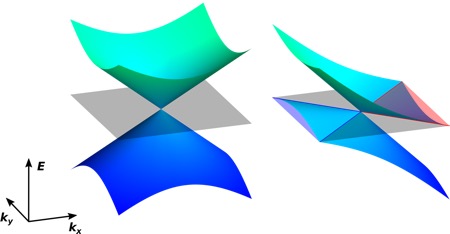Type II Dirac fermions, first predicted theoretically by MARVEL researchers, now experimentally verified
Fiorien Bonthuis, EPFL, NCCR MARVEL
The search for new particles is traditionally the field of high-energy physics. However, elementary particles sometimes have quasiparticle analogs in condensed matter: in some materials, collective states fulfill the same mathematical equations as some elementary particle. Indeed, through quasiparticles we can study particles that elude high-energy experiments. What is more, unlike fundamental particles, quasiparticles in condensed matter do not necessarily obey Lorentz invariance. That is, low energy excitations in condensed matter, might instantiate (quasi)particles that are not in the standard model: given the right material, we might find not only analogs of the standard model's (or type I) particles, but also their type-II counterparts that violate Lorentz invariance. This is precisely what Alexey Soluyanov's team predicted: that type II Weyl fermions can be hosted in certain topological semimetals (see figure).1 Their findings also hold for type II Dirac fermions, which break Lorentz invariance in the same way. The existence of such type II Dirac fermions has now been confirmed experimentally.2-6
More details can be found in an editorial comment by Alexey A. Soluyanov.7 Indeed, since the publication of this editorial, experimental confirmation of the predictions has kept pouring in, and a fourth5 and a fifth6 study have been added to the three papers mentioned there.

Figure: Type I and II Weyl fermions. Illustration of the energy landscape as a function of momentum for two electron states, forming a type-I (left) and type-II (right) Weyl node. In both cases, the two energy surfaces have a cone-like shape, meeting in a single point. However, for the type-II Weyl node, these cones are strongly tilted. As a result, a cut (grey plane) at a given energy gives an open surface, while it is closed (point-like) for the type-I Weyl node (figure by Dominik Gresch).
References
[1] A. A. Soluyanov, D. Gresch, Z. J. Wang, Q. S. Wu, M. Troyer, X. Dai, and B. A. Bernevig, Type-II Weyl semimetals Nature 527 (7579), 495 (2015) http://dx.doi.org/10.1038/nature15768
[2] H.-J. Noh, J. Jeong, E.-J. Cho, K. Kim, B. I. Min, and B.-G. Park, Experimental Realization of Type-II Dirac Fermions in a PdTe2 Superconductor Phys Rev Lett 119 (1), 016401 (2017) http://dx.doi.org/10.1103/PhysRevLett.119.016401
[3] F. Fei, X. Bo, R. Wang, B. Wu, J. Jiang, D. Fu, M. Gao, H. Zheng, Y. Chen, X. Wang, H. Bu, F. Song, X. Wan, B. Wang, and G. Wang, Nontrivial Berry phase and type-II Dirac transport in the layered material PdTe2Phys Rev B 96 (4), 041201 (2017) http://dx.doi.org/10.1103/PhysRevB.96.041201
[4] M. Yan, H. Huang, K. Zhang, E. Wang, W. Yao, K. Deng, G. Wan, H. Zhang, M. Arita, and H. Yang, Lorentz-violating type-II Dirac fermions in transition metal dichalcogenide PtTe2 arXiv:1607.03643 (2016) https://arxiv.org/abs/1607.03643
[5] S.-Y. Xu, N. Alidoust, G. Chang, H. Lu, B. Singh, I. Belopolski, D. S. Sanchez, X. Zhang, G. Bian, H. Zheng, M.-A. Husanu, Y. Bian, S.-M. Huang, C.-H. Hsu, T.-R. Chang, H.-T. Jeng, A. Bansil, T. Neupert, V. N. Strocov, H. Lin, S. Jia, and M. Z. Hasan, Discovery of Lorentz-violating type II Weyl fermions in LaAlGe Science Advances 3 (6) (2017) http://dx.doi.org/10.1126/sciadv.1603266
[6] A. Tamai, Q. S. Wu, I. Cucchi, F. Y. Bruno, S. Riccò, T. K. Kim, M. Hoesch, C. Barreteau, E. Giannini, C. Besnard, A. A. Soluyanov, and F. Baumberger, Fermi Arcs and Their Topological Character in the Candidate Type-II Weyl Semimetal MoTe2 Phys Rev X 6 (3), 031021 (2016) http://dx.doi.org/10.1103/PhysRevX.6.031021
[7] A. A. Soluyanov, Type-II Dirac Fermions Spotted Physics 10, 74 (2017) http://dx.doi.org/10.1103/Physics.10.74
Low-volume newsletters, targeted to the scientific and industrial communities.
Subscribe to our newsletter